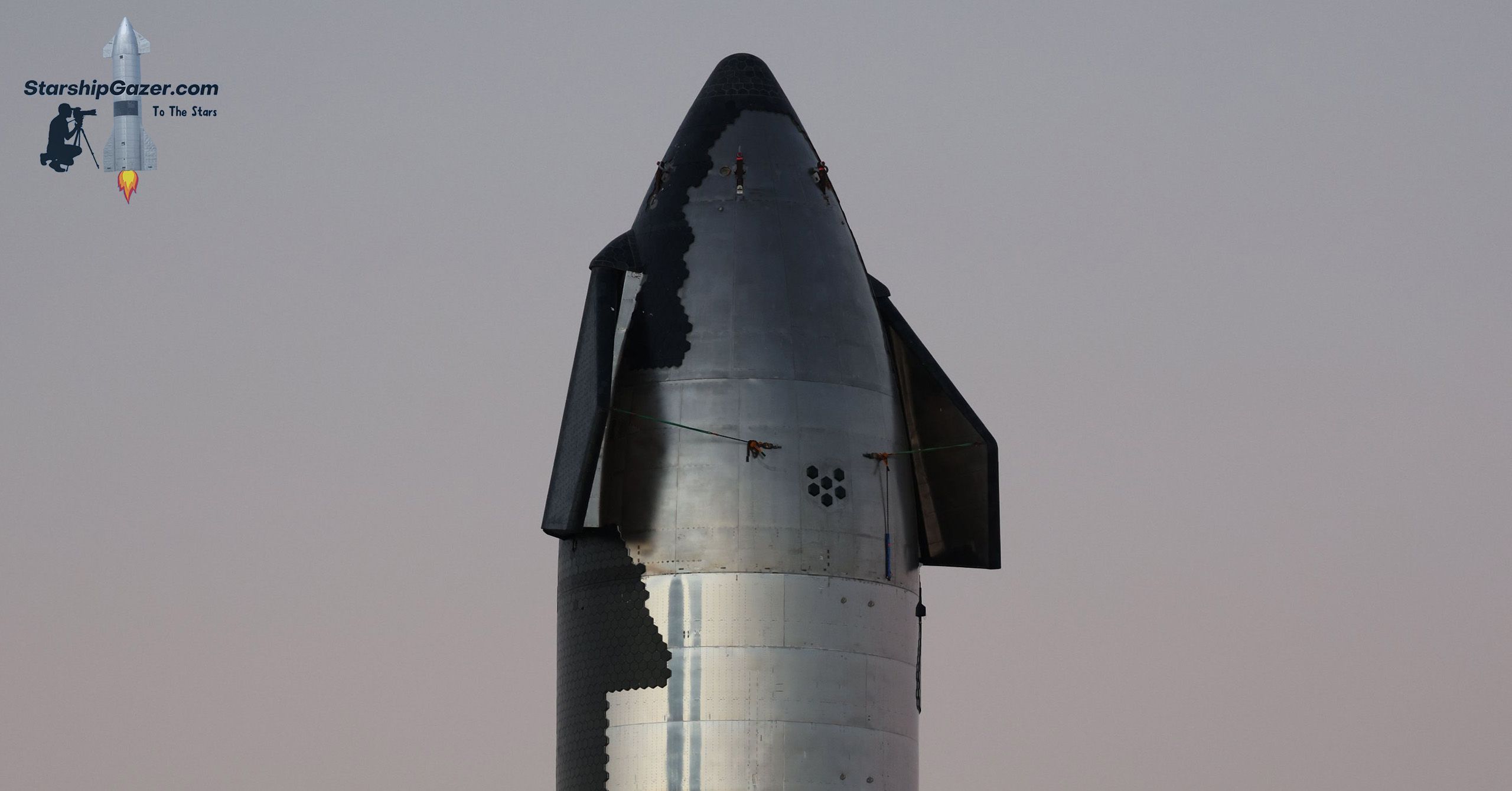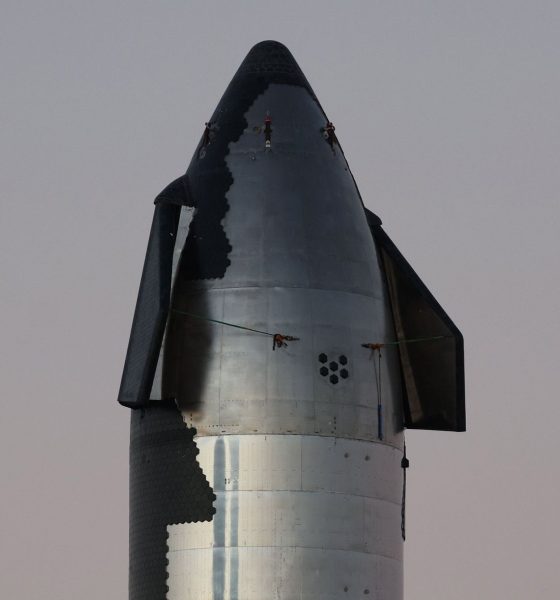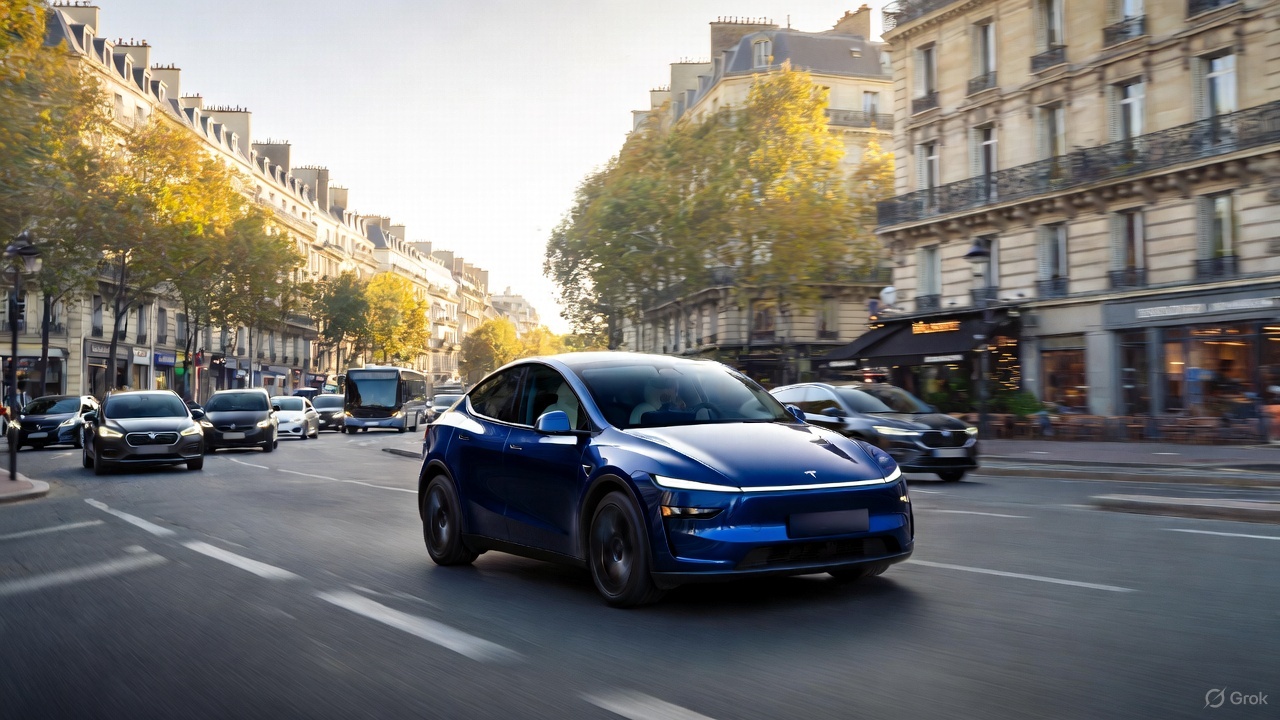

News
SpaceX installs new Starship on static fire test stand
SpaceX may be focused on preparing Starship S24 and Super Heavy Booster 7 for their potentially imminent orbital launch debut, but the rest of the company’s Starship factory isn’t just sitting around.
The laser focus on carefully testing Ship 24 and Booster 7 may have limited the effectiveness of Starbase rocket production, but the factory has continued to produce new ships and boosters. SpaceX has even conducted some limiting testing of a pair of prototypes meant to follow in the footsteps of S24 and B7. In mid-January, that process entered a new and more active phase as SpaceX transported Starship S25 from the factory to the launch pad.
The trip is not Ship 25’s first. Starship S25 first headed to SpaceX’s South Texas launch and test facilities on October 19th, 2022, shortly after the vehicle was fully assembled. Around three weeks of testing followed, and now Ship 25 is back for more.
The update that's rolling out to the fleet makes full use of the front and rear steering travel to minimize turning circle. In this case a reduction of 1.6 feet just over the air— Wes (@wmorrill3) April 16, 2024
Ship 25
The first round of tests was thorough and put Ship 25 through a pneumatic proof test, multiple cryogenic proof tests, and likely a few simulated thrust tests using six hydraulic rams.
“Ship 25 was removed from SpaceX’s other Starship test stand on November 8th, it was rolled back to Starbase’s Starship factory. Ship 25 first rolled to the launch site on October 19th and has since completed four visible tests. On October 28th, Ship 25 survived a pneumatic proof test that showed that its tanks were leak-free and capable of surviving flight pressures (roughly 6-8.5 bar or 90-125 psi). Three cryogenic proof tests followed on November 1st, 2nd, and 7th. The first cryoproof was likely just that – a test that pressurized Ship 25’s tanks and filled them with cryogenic liquid nitrogen (LN2) or a combination of liquid oxygen and LN2.
The next two tests likely took advantage of the customized test stand, which has been semi-permanently outfitted with a set of hydraulic rams that allow SpaceX to simulate the thrust of six Raptor engines while Starship’s structures are chilled to cryogenic temperatures and loaded with roughly 1000 tons (~2.2M lb) of cryogenic fluids. If a Starship can survive those stresses on the ground, the assumption is that it will likely survive similar stresses in flight.”
Teslarati.com – October 20th, 2022
As usual, SpaceX didn’t comment on the development or indicate how that initial proof testing had gone, but Ship 25’s January 14th, 2023 return to the launch site all but guaranteed that that testing had gone more or less according to plan. On January 17th, SpaceX lifted Ship 25 onto Starbase’s only Starship static fire test stand, further confirming that Ship 25 proof testing went to plan.
Soon after its November 2022 return to Starbase’s build site, six Raptor engines were moved into the High Bay and installed on Ship 25. The Starship’s aft was then likely buttoned up with a heat shield before it headed to the test site to begin its static fire test campaign. That campaign could tell us a lot about the status of Starship prototypes. To date, only two Ships have completed full six-Raptor static fire tests, and both took days, weeks, or months to build up to those six-engine milestones with multiple smaller tests. If Ship 25 were to skip those preliminary tests and immediately conduct a six-engine static fire, it would be a sign that SpaceX is significantly more confident in the current Starship design.
Booster 9
Ship 25 is believed to be paired with Super Heavy Booster 9, which recently finished its own round of proof tests. About two months behind Ship 25, Booster 9 rolled out of its Starbase assembly bay and headed to the launch site on December 15th, 2022. The Super Heavy prototype ultimately completed two partial cryogenic proof tests on December 21st and 29th, during which it was likely loaded with around a thousand tons of liquid nitrogen to simulate explosive liquid oxygen and methane propellant. Booster 9 then returned to Starbase’s factory on January 10th, 2023.
Assuming those tests went well, Raptor engine installation could begin at any moment. However, thanks to significant design changes and upgrades present on Booster 9, outfitting and testing this Super Heavy could take longer than usual. Many smaller changes are present, but the most significant by far is the addition of an upgraded version of Raptor. The engine’s combustion-related hardware is likely the same as the Raptor V2 engines present on Booster 7, Ship 24, and Ship 25. But the hardware used to steer each engine – called thrust vector control (TVC) – has been completely changed.
Instead of using a complex web of plumbing and hydraulic power units bolted to the side of Super Heavy, Booster 9’s 13 central Raptors will be electrically steered. That has allowed SpaceX to remove those power units (streamlining Booster 9’s exterior) and reduce the already rats nest of plumbing required to fuel, control, power, and steer dozens of high-performance rocket engines on one booster. SpaceX has been testing electric Raptor TVC for months at its McGregor, Texas development facilities, but it’s unclear if the new technology has progressed to the point that 13 upgraded engines are ready to be installed on Booster 9. In the meantime, SpaceX may install Booster 9’s fixed outer ring of 20 Raptor V2 engines – none of which gimbal or need new electric TVC hardware.
Once all 33 engines are installed, it’s likely that Booster 9 will be thoroughly tested to ensure that all 13 electrically-steered engines work well together before, during, and after numerous static fire tests. SpaceX will also need to verify that the batteries likely powering those new systems function as expected. During the peak stresses they will likely experience, the electric TVC could need to rapidly redirect more than 3000 tons (~6.6 million lbf) of thrust multiple times per second. The peak power required from Super Heavy’s batteries will likely be immense as a result.
For now, the start of Super Heavy B9’s own static fire test campaign could be months away and will have to wait until Starbase’s only orbital launch mount – currently occupied by Booster 7, Ship 24, and Starship’s first orbital launch campaign – is vacated. With that orbital launch debut unlikely to happen before March 2023, Booster 9 has plenty of time to relax inside Starbase’s Wide Bay while Ship 25 begins static fire testing at a separate stand.

News
Man credits Grok AI with saving his life after ER missed near-ruptured appendix
The AI flagged some of the man’s symptoms and urged him to return to the ER immediately and demand a CT scan.

A 49-year-old man has stated that xAI’s Grok ended up saving his life when the large language model identified a near-ruptured appendix that his first ER visit dismissed as acid reflux.
After being sent home from the ER, the man asked Grok to analyze his symptoms. The AI flagged some of the man’s symptoms and urged him to return immediately and demand a CT scan. The scan confirmed that something far worse than acid reflux was indeed going on.
Grok spotted what a doctor missed
In a post on Reddit, u/Tykjen noted that for 24 hours straight, he had a constant “razor-blade-level” abdominal pain that forced him into a fetal position. He had no fever or visible signs. He went to the ER, where a doctor pressed his soft belly, prescribed acid blockers, and sent him home.
The acid blockers didn’t work, and the man’s pain remained intense. He then decided to open a year-long chat he had with Grok and listed every detail that he was experiencing. The AI responded quickly. “Grok immediately flagged perforated ulcer or atypical appendicitis, told me the exact red-flag pattern I was describing, and basically said “go back right now and ask for a CT,” the man wrote in his post.
He copied Grok’s reasoning, returned to the ER, and insisted on the scan. The CT scan ultimately showed an inflamed appendix on the verge of rupture. Six hours later, the appendix was out. The man said the pain has completely vanished, and he woke up laughing under anesthesia. He was discharged the next day.
How a late-night conversation with Grok got me to demand the CT scan that saved my life from a ruptured appendix (December 2025)
byu/Tykjen ingrok
AI doctors could very well be welcomed
In the replies to his Reddit post, u/Tykjen further explained that he specifically avoided telling doctors that Grok, an AI, suggested he get a CT scan. “I did not tell them on the second visit that Grok recommended the CT scan. I had to lie. I told them my sister who’s a nurse told me to ask for the scan,” the man wrote.
One commenter noted that the use of AI in medicine will likely be welcomed, stating that “If AI could take doctors’ jobs one day, I will be happy. Doctors just don’t care anymore. It’s all a paycheck.” The Redditor replied with, “Sadly yes. That is what it felt like after the first visit. And the following night could have been my last.”
Elon Musk has been very optimistic about the potential of robots like Tesla Optimus in the medical field. Provided that they are able to achieve human-level articulation in their hands, and Tesla is able to bring down their cost through mass manufacturing, the era of AI-powered medical care could very well be closer than expected.
News
Tesla expands Model 3 lineup in Europe with most affordable variant yet
The Model 3 Standard still delivers more than 300 miles of range, potentially making it an attractive option for budget-conscious buyers.

Tesla has introduced a lower-priced Model 3 variant in Europe, expanding the lineup just two months after the vehicle’s U.S. debut. The Model 3 Standard still delivers more than 300 miles (480 km) of range, potentially making it an attractive option for budget-conscious buyers.
Tesla’s pricing strategy
The Model 3 Standard arrives as Tesla contends with declining registrations in several countries across Europe, where sales have not fully offset shifting consumer preferences. Many buyers have turned to options such as Volkswagen’s ID.3 and BYD’s Atto 3, both of which have benefited from aggressive pricing.
By removing select premium finishes and features, Tesla positioned the new Model 3 Standard as an “ultra-low cost of ownership” option of its all-electric sedan. Pricing comes in at €37,970 in Germany, NOK 330,056 in Norway, and SEK 449,990 in Sweden, depending on market. This places the Model 3 Standard well below the “premium” Model 3 trim, which starts at €45,970 in Germany.
Deliveries for the Standard model are expected to begin in the first quarter of 2026, giving Tesla an entry-level foothold in a segment that’s increasingly defined by sub-€40,000 offerings.
Tesla’s affordable vehicle push
The low-cost Model 3 follows October’s launch of a similarly positioned Model Y variant, signaling a broader shift in Tesla’s product strategy. While CEO Elon Musk has moved the company toward AI-driven initiatives such as robotaxis and humanoid robots, lower-priced vehicles remain necessary to support the company’s revenue in the near term.
Reports have indicated that Tesla previously abandoned plans for an all-new $25,000 EV, with the company opting to create cheaper versions of existing platforms instead. Analysts have flagged possible cannibalization of higher-margin models, but the move aims to counter an influx of aggressively priced entrants from China and Europe, many of which sell below $30,000. With the new Model 3 Standard, Tesla is reinforcing its volume strategy in Europe’s increasingly competitive EV landscape.
News
Tesla FSD (Supervised) stuns Germany’s biggest car magazine
FSD Supervised recognized construction zones, braked early for pedestrians, and yielded politely on narrow streets.

Tesla’s upcoming FSD Supervised system, set for a European debut pending regulatory approval, is showing notably refined behavior in real-world testing, including construction zones, pedestrian detection, and lane changes, as per a recent demonstration ride in Berlin.
While the system still required driver oversight, its smooth braking, steering, and decision-making illustrated how far Tesla’s driver-assistance technology has advanced ahead of a potential 2026 rollout.
FSD’s maturity in dense city driving
During the Berlin test ride with Auto Bild, Germany’s largest automotive publication, a Tesla Model 3 running FSD handled complex traffic with minimal intervention, autonomously managing braking, acceleration, steering, and overtaking up to 140 km/h. It recognized construction zones, braked early for pedestrians, and yielded politely on narrow streets.
Only one manual override was required when the system misread a converted one-way route, an example, Tesla stated, of the continuous learning baked into its vision-based architecture.
Robin Hornig of Auto Bild summed up his experience with FSD Supervised with a glowing review of the system. As per the reporter, FSD Supervised already exceeds humans with its all-around vision. “Tesla FSD Supervised sees more than I do. It doesn’t get distracted and never gets tired. I like to think I’m a good driver, but I can’t match this system’s all-around vision. It’s at its best when both work together: my experience and the Tesla’s constant attention,” the journalist wrote.
Tesla FSD in Europe
FSD Supervised is still a driver-assistance system rather than autonomous driving. Still, Auto Bild noted that Tesla’s 360-degree camera suite, constant monitoring, and high computing power mark a sizable leap from earlier iterations. Already active in the U.S., China, and several other regions, the system is currently navigating Europe’s approval pipeline. Tesla has applied for an exemption in the Netherlands, aiming to launch the feature through a free software update as early as February 2026.
What Tesla demonstrated in Berlin mirrors capabilities already common in China and the U.S., where rival automakers have rolled out hands-free or city-navigation systems. Europe, however, remains behind due to a stricter certification environment, though Tesla is currently hard at work pushing for FSD Supervised’s approval in several countries in the region.








